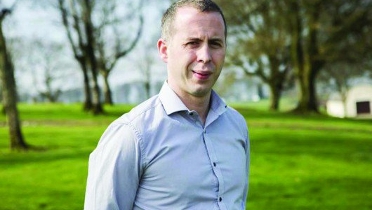
Focus on research: Prof Donagh Berry, VistaMilk
VistaMilk is a new research centre co-funded by Science Foundation Ireland and the Dept of Agriculture, Food & The Marine, and led by Teagasc from its base in Fermoy. In this interview we talk to centre director Prof Donagh Berry about the challenges of managing a multidisciplinary research team and the limits of predictive models.
Tell us about your career to date.
I am a senior principal investigator in quantitative genetics at Teagasc in Moorepark and hold an professorship appointment at several international institutes. Following my bachelor degree in Agricultural Science at University College Dublin in 2000, I undertook a PhD in dairy cattle genetics in Wageningen University, the Netherlands.
In my Teagasc capacity, I am responsible for the research on genetics in dairy cattle and for the development and implementation of genomic evaluations in dairy cattle, beef cattle and sheep in Ireland. In my role at VistaMilk I lead a team of more than 200 scientists in the development and deployment of digital technologies in precision dairy production.
You would expect VistaMilk to be starting small. With more than 200 researchers involved that doesn’t seem to be the case. What challenges does that bring?
Arguably the greatest challenge will be managing communication between researchers. There are three main reasons for this: First, many are geographically distant from each other. A lot of effective communication is based on body language and tone which is not captured in e-mail. Second, we have vastly different disciplines, each with their own language and stream of acronyms. For example, AI means ‘artificial intelligence’ in ICT but ‘artificial insemination’ in the biological sciences. Finally, researchers hail from either industry or academia, often with differing opinions on the impact horizon of the research.
The short- and long-term problem statements underpinned by the seismic challenges facing dairy production, agriculture and society in general, are well understood by the centre team and there is complete buy-in among the enthused partners in the vision of VistaMilk. The beauty of VistaMilk is that no one can go it alone, and everyone is completely aware of this.
What kind of research are we going to see coming out of VistaMilk?
VistaMilk will digitalise dairy production across the entire production chain all the way from the soil and pasture, through the cow and eventually into the product.
The tagline of Vistamilk is “milk by design” thus positioning the dairy industry to meet the nutritional demands of the various demographics of society. Moreover, these consumer demands must be met concurrent with greater uncertainty in both input availability and prices as well as output demand and value; such uncertainty and volatility demands greater efficiencies and resilience across the entire food chain.
Key to achieving efficiency gains is the actual measurement, monitoring and benchmarking of a whole plethora of performance metrics – measurement, capture, integration, analyses and delivery are all areas where new digital technologies can excel. Addressing the entire production and processing chain, rather than solely focusing on the individual components of that chain, ensure any efficiency gains in one field does not have any downstream repercussions.
What areas of Agri-food research are exciting you at the moment?
The most exiciting area, which of course happens to be the most difficult, is the complete integration of the dairy food chain from soil to society meaning cognisance is taken of any upstream and downstream consequences, good or bad, arising from alterations made in any of the links within that chain. There is no such centre of such scale globally.
Prediction models to-date in agriculture tend to do exactly that and nothing else – they predict. VistaMilk will transform the state-of-the-art from prediction models to prescription models or in other words not just tell the producer or processor everything that is likely to happen, but instead inform of what actions, remedial or otherwise, need to be taken; in some instances the recommendations will be accompanied by a justification based on data (eg explainable artificial intelligence). Again, this highlights to advantage of the centre in that it combines experts in the Agri-Food and ICT domains to generate a truly collaborative and innovative ecosystem addressing problem statements of today and the future.






Subscribers 0
Fans 0
Followers 0
Followers